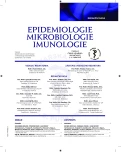Epidemiologie kmenů Cronobacter spp. izolovaných z hospitalizovaných pacientů FN Olomouc (Česká republika)
Authors:
O. Holý 1; J. Petrželová 2; V. Hanulík 2; M. Chromá 2; I. Matoušková 1; S. J. Forsythe 3
Authors‘ workplace:
Department of Preventive Medicine, Faculty of Medicine and Dentistry, Palacký University Olomouc, Olomouc, Czech Republic
1; Department of Microbiology, Faculty of Medicine and Dentistry, Palacký University Olomouc, Olomouc, Czech Republic
2; School of Science and Technology, Nottingham Trent University, Nottingham, United Kingdom
3
Published in:
Epidemiol. Mikrobiol. Imunol. 63, 2014, č. 1, s. 69-72
Category:
Short Communication
Overview
Informace o incidenci a výskytu kmenů Cronobacter spp. byly shromážděny ze záznamů za sedmileté období – 2005–2011. Většina izolátů Cronobacter spp. (n = 91) pocházela z výtěrů z krku (61), následovala moč (5), tracheální aspiráty (5), bronchoalveolární laváž (4), kanyly (4), a sputum (3). Toto je první studie, která na základě klinických dat zohledňuje věk pacienta a výskyt kmenů Cronobacter spp. za období sedmi let – 2005–2011. Je patrný velmi vysoký výskyt (63,7 % kmenů, n = 91) u dětí ve věku 1–14 let.
Klíčová slova:
Cronobacter spp. – meningitida – nozokomiální infekce
Sources
1. Hariri S, Joseph S, Forsythe SJ. Predominance of Cronobacter sakazakii ST4 clonal complex strains in Cronobacter neonatal meningitis infections in US 2011. Emerg Infect Dis, 2013;19 : 175–177.
2. Bowen AB, Braden CR. Invasive Enterobacter sakazakii disease in infants. Emerg Infect Dis, 2006;12 : 1185–1189.
3. Joseph S, Forsythe SJ. Insights into the emergent bacterial pathogen Cronobacter spp., generated by multilocus sequence typing and analysis. Front Microbiol, 2012;3 : 397.
4. Himelright I, Harris E, Lorch V. Enterobacter sakazakii infections associated with the use of powdered infant formula-Tennessee. 2001, JAMA, 2002;287 : 2204–2205.
5. FAO/WHO [Food and Agriculture Organization of the United Nations/World Health Organization], 2008. Enterobacter sakazakii (Cronobacter spp.) in powdered follow-up formulae. Microbiological Risk Assessment Series No. 15, Rome. 90 pp.
6. Abbott S. 37. Klebsiella, Enterobacter, Citrobacter, Serratia, Plesiomonas, and Other Enterobacteriaceae. In: Versalovic J, Carroll KC, Funke G, Jorgensen JH, et al. Manual of Clinical Microbiology. 10th edition, ASM Press; 639–657.
7. CLSI (Clinical and Laboratory Standards Institute): performance standards for antimicrobial susceptibility testing, 19th informational supplement, M100-S19. Clinical and Laboratory Standards Institute, Wayne (PA, USA), 2009.
8. Joseph S, Cetinkaya E, Drahovska H, Levican A, et al. Cronobacter condimenti, sp. nov., isolated from spiced meat and Cronobacter universalis sp. nov., a novel species designation for Cronobacter sp. genomospecies 1, recovered from a leg infection, water, and food ingredients. Int J Syst Evol Microbiol, 2012;62 : 1277–1283.
9. Friedemann M. Enterobacter sakazakii in food and beverages (other than infant formula and milk powder). Int J Food Microbiol, 2007;116 : 1–10.
10. Iversen C, Forsythe SJ. Isolation of Enterobacter sakazakii and other Enterobacteriaceae from powdered infant formula milk and related products. Food Microbiol, 2004;21 : 771–776.
11. Turcovský I, Kuniková K, Drahovská H, Kaclíková E. Biochemical and molecular characterization of Cronobacter spp. (formerly Enterobacter sakazakii) isolated from foods. Antonie van Leeuwenhoek, 2011;99 : 257–269.
12. Holý O, Forsythe SJ. Cronobacter species as emerging causes of healthcare-associated infection. J Hospt Infection [Epub ahead of print].
Labels
Hygiene and epidemiology Medical virology Clinical microbiologyArticle was published in
Epidemiology, Microbiology, Immunology

2014 Issue 1
Most read in this issue
- Legionelové infekce – opomíjený problém
- Bakterie komplexu Burkholderia cepacia – epidemiologie a diagnostika infekcí u pacientů s cystickou fibrózou
- Epidemiologické šetření v pěti ambulancích Kliniky zubního lékařství LF UP v Olomouci a FN Olomouc
- Klinické a epidemiologické charakteristiky pacientů hospitalizovaných pro těžký průběh chřipky v sezoně 2012–2013
